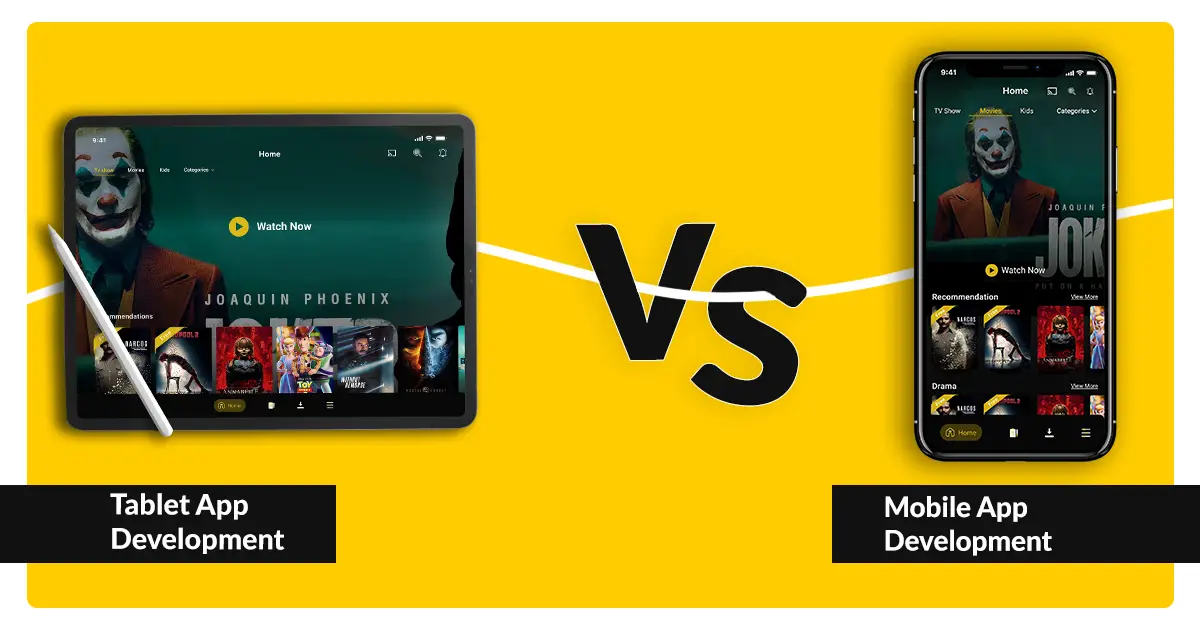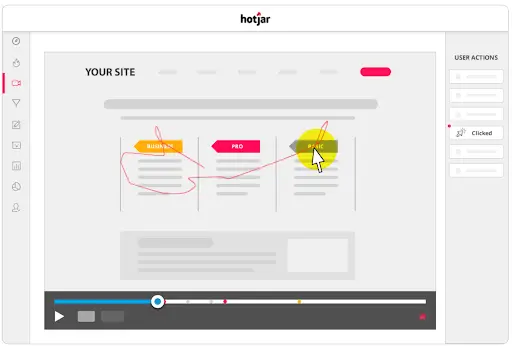Tablets and smart phones have become an integral part of our lives. With an increasing number of people using these devices to access the internet and interact with apps, it has become essential for businesses to develop mobile apps to meet the needs of their customers. However, with so many different types of devices available, choosing between tablet app development and mobile app development can be a difficult decision.
In this blog post, we will explore the differences between tablet apps and mobile apps, and help you decide which one is right for your business.
The Rise of Tablets: Key Statistics You Need to Know
Though, before moving to any conclusion, lets first move to the major difference between tablet apps and mobile apps
Understanding the Differences between Tablet Apps and Mobile Apps
| Aspect | Tablet Apps | Mobile Apps |
|---|---|---|
| Screen Size | Large screen size, typically 7-10 inches or more | Small screen size, typically 4-6 inches |
| Interface Design | Can accommodate more complex interface designs | Must be designed with limited screen space |
| Hardware Features | Often includes additional hardware features | Fewer hardware features available |
| Processing Power | Generally more powerful hardware | Typically less powerful hardware |
| Battery Life | Longer battery life due to larger battery size | Shorter battery life due to smaller batteries |
| Use Case | Often used for tasks that require more screen real estate. Healthcare, Automotive Industries many more | Typically used for on-the-go tasks |
| App Store Presence | Smaller pool of tablet-specific apps available | Large pool of mobile-specific apps available |
Note that these differences are generalizations, and there can be overlap between tablet and mobile app design and functionality. Ultimately, the specific needs and goals of your app will determine which type of device is the best fit for your project.
Finally, user behavior and context are also important considerations.
Tablet users tend to interact with apps differently than mobile users, often using them in different locations and for different purposes.
For example, tablet users are more likely to use apps in a leisurely setting, such as at home or in a coffee shop, and may spend more time using them than mobile users. This means that tablet apps should be designed to be more immersive and engaging, with more advanced features and more detailed graphics.
Additionally, Mobile apps, on the other hand, should be designed for quick and easy use on the go, with simpler interfaces and streamlined functionality.
Native App Development vs Hybrid App Development for Tablets and Mobile Devices
| Aspect | Native App Development | Hybrid App Development |
|---|---|---|
| Platform-Specific Functionality | Offers full access to device-specific features and functionality | Limited access to device-specific features and functionality |
| User Experience (UX) | Offers the best UX as the app is designed specifically for a platform | May not offer the same level of UX as native apps |
| Performance | Offers the best performance as the app is optimized for the platform | May experience performance issues due to cross-platform coding |
| Development Time | Longer development time due to creating separate code bases for each platform | Shorter development time as code can be reused across platforms |
| Cost | Can be more expensive due to creating separate code bases for each platform | Can be less expensive due to code reuse and faster development time |
| Maintenance | Requires separate maintenance for each platform | Easier to maintain as code can be reused across |
Note that the choice between native and hybrid app development will depend on various factors, such as your budget, timeline, target audience, and app requirements.
A skilled app development team can help guide you in making the right decision for your project or Looking to build an MVP app for your startup? Check out our MVP app development guide for expert tips and advice
Designing for User Experience (UX) on Tablets vs Mobile Devices
Remember, designing for user experience (UX) is a critical aspect of app development. With the rise of tablets and mobile devices, it’s important to consider the differences between designing for these platforms.
Here, we’ll explore some key considerations for designing a great UX on both tablet and mobile devices.
Tablets App UI/UX design:
Mobile Devices App UI/UX design:
By considering the unique design challenges and opportunities presented by both tablets and mobile devices, you can create an app that delivers an optimized user experience on both platforms. Our mobile app design service is focused on creating intuitive and user-friendly interfaces that engage and delight users
Cost Considerations for Developing Tablet Apps vs Mobile Apps
Developing a mobile or tablet app can be a significant investment for businesses, so it’s important to consider the cost factors carefully.
When it comes to average costs for app development, there is no one-size-fits-all answer. The cost of app development can vary widely depending on the factors mentioned above, as well as the complexity and scope of the project
Factors that can influence the cost of app development:
- 1. Platform – Developing for multiple platforms (iOS, Android, etc.) will increase development costs as each platform requires separate coding and testing.
- 2. Features – The complexity and number of features required in the app can significantly impact development costs.
- 3. Design – Creating custom designs and graphics for an app can increase the cost of development.
- 4. Development team – The size and experience level of the development team can also impact the cost of app development.
- 5. API Integration – The number of APIs you integrate also adds to the cost of your mobile and tablet app development
Generally, however, tablet app development tends to be more expensive than mobile app development due to the larger screen size and more complex features.
Strategies for Minimizing Costs and Maximizing ROI
- 1. Prioritize features – Identify the must-
in the development process to avoid unnecessary costs. - 2. Use pre-built modules and templates – Utilizing pre-built modules and templates can save time and money during the development process.
- 3. Work with experienced developers – Experienced developers can help identify cost-saving opportunities and avoid potential pitfalls in the development process.
- 4. Test early and often – Testing the app throughout the development process can help identify and address issues early on, saving time and money in the long run.
Optimizing Tablet Apps vs Mobile Apps for App Store Ranking
App Store Optimization (ASO) is the process of optimizing a mobile app’s visibility and ranking in an app store’s search results. ASO can have a significant impact on the success of an app, as it can drive organic downloads and user engagement.
App Store Optimization (ASO) Strategies for Tablet Apps:
App Store Optimization (ASO) Strategies for Mobile Apps:
Tips for Better Visibility and Higher Rankings in App Stores:
By following these strategies and tips, businesses can improve their app’s visibility and ranking in app stores, helping to drive downloads and engagement.
Industries Leveraging Tablet Apps for Business Success
These are just a few examples of industries that use tablets, and the list continues to grow as tablets become more versatile and affordable.
Conclusion – Tablet App Development vs Mobile App Development
At the end, we can say that, tablet app development and mobile app development each have their own unique advantages and challenges. By understanding the differences between these two platforms and developing apps that are for the specific needs and behaviors of their users, businesses can create mobile apps that are engaging, intuitive, and highly effective.
We specialize in creating high-quality mobile apps meant for both tablet and mobile devices. Our team of experienced app developers and designers can help businesses develop apps that offer a seamless user experience, with interfaces and functionality tailored to the specific needs and behaviors of their users.
Whether you’re looking to develop a tablet app, a mobile app, or both, we can work with you to create a customized solution that meets your needs and exceeds your expectations. Get in touch with our expert team to know more about mobile and tablet app development services. We can help your business succeed in the fast-paced world of mobile app development.
Let’s Brainstorm Your App Together!
FAQs
Yes, a mobile app can typically be used on a tablet. Most mobile apps are designed to be responsive and adapt to different screen sizes and resolutions, including those of tablets. However, the user experience may not be optimal on a tablet if the app was designed primarily for a smaller screen size. In such cases, it may be more effective to develop a separate tablet app for the larger screen and enhanced tablet features.
Developers can use a variety of tools and platforms to build tablet apps, depending on their preferences and expertise. However, some development tools are better for tablet app development due to their support for larger screens and specific tablet features.
For example, some popular development tools for tablet app development include Xcode, Android Studio, Xamarin, and Unity. These tools provide features such as drag-and-drop interfaces, debugging tools, and integration with third-party libraries and APIs.
Additionally, some tablet devices have specific development kits and resources available to help developers create optimized apps. For example, Apple offers the iPadOS Human Interface Guidelines for designing and developing iPad apps, while Google has Android Tablet Resources and Best Practices for designing and developing apps for Android tablets.
Overall, while there may not be any specific tools required for tablet app development, developers should consider choosing tools optimized for larger screens and offer support for tablet-specific features to ensure the best possible user experience on tablets.









Leave a Reply